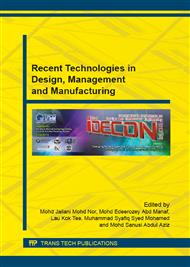p.42
p.47
p.52
p.59
p.63
p.68
p.73
p.79
p.83
Conceptual Design of Kenaf Polymer Composites Automotive Spoiler Using TRIZ and Morphology Chart Methods
Abstract:
Spoilers are part of an automotive exterior bodywork system that acts to create additional down force for higher traction. In this paper, a new conceptual design of automotive spoiler component using kenaf polymer composites was developed using integrated TRIZ and morphology chart design method. The aim is to enable direct application of kenaf polymer composites to the spoiler design to achieve better environmental performance of the component while maintaining the required structural strength for safe and functional operation. The overall process involved two major stages, which are the idea generation and concept development. TRIZ method was applied in the idea generation stage where specific solution strategies for the design were created. In the concept development stage, the specific TRIZ solution strategies obtained were later refined into relevant alternative system elements using Morphology chart method. Finally, a new conceptual design of an automotive spoiler was developed using the combination of the identified system elements. The integrated TRIZ and morphology chart method were found to be new tools that can be used effectively in the concept design stage, especially in cases where direct material substitution is given the main focus for the new product development.
Info:
Periodical:
Pages:
63-67
Citation:
Online since:
May 2015
Authors:
Price:
Сopyright:
© 2015 Trans Tech Publications Ltd. All Rights Reserved
Share:
Citation:


